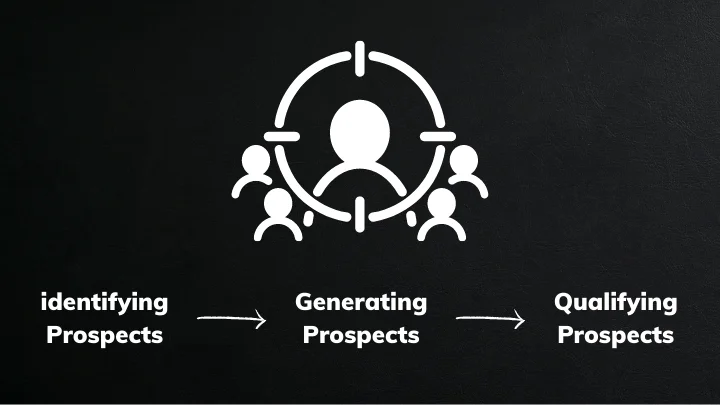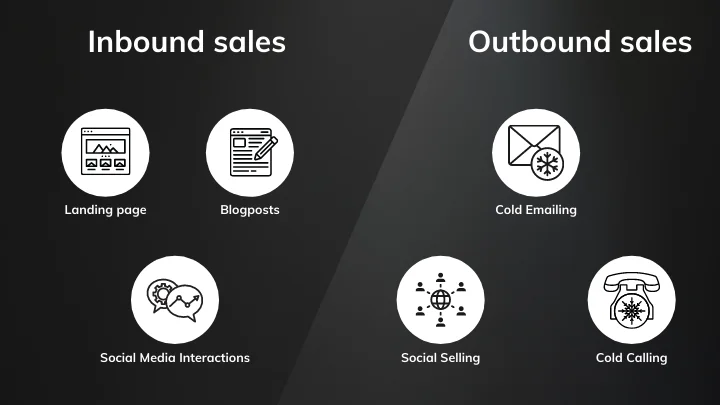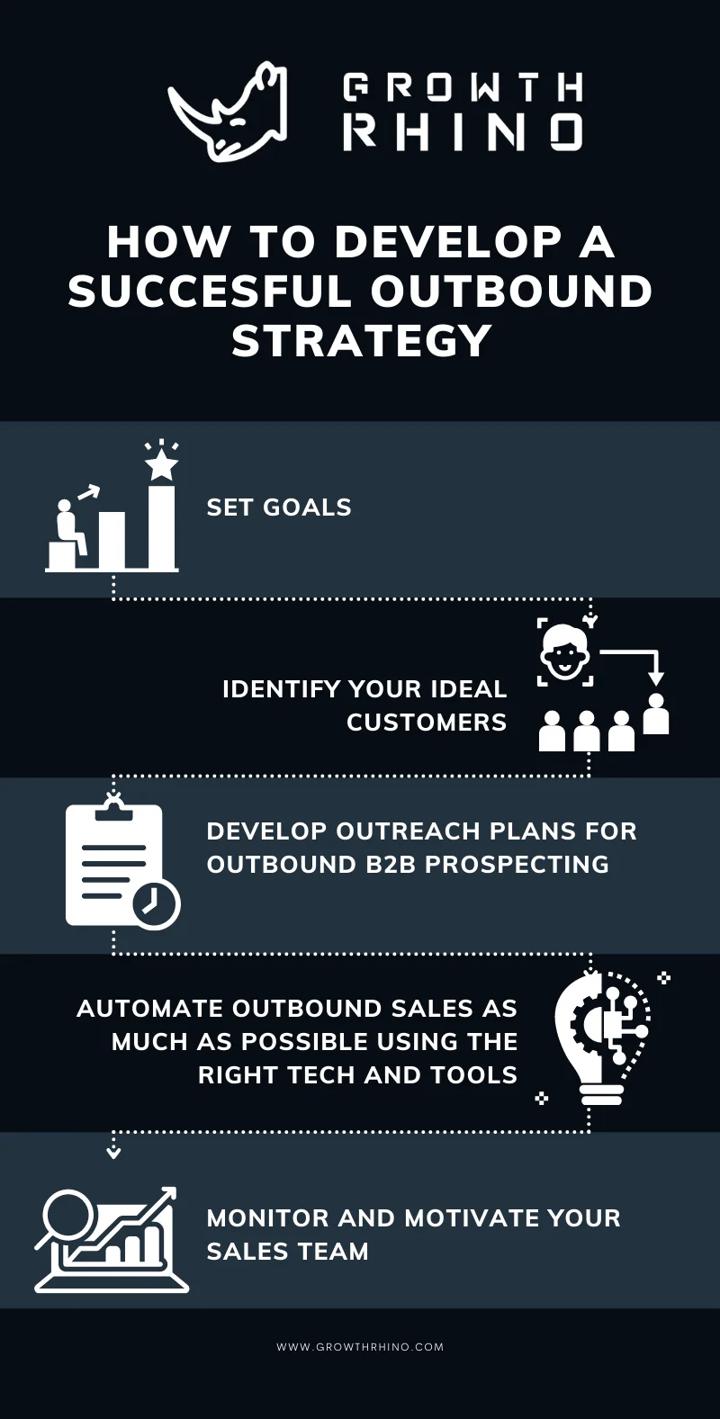
Are you a B2B business struggling to increase revenue? If so, it’s time for you to take outbound prospecting strategies seriously.
Outbound sales are what separates the top performers from everyone else. But what exactly is the outbound prospecting process and why should your company be doing it?
What does it take to develop an effective and successful sales outbound process? This blog post will answer all of those questions and more!
What is an Outbound Sales Prospecting?

Outbound prospecting strategies are the process of identifying, generating, and qualifying prospects without them coming to you. This type of sales technique usually involves cold calls or cold outreach in order to find potential customers. It can also be used as a part of an inbound leads strategy where outbound calls are made after someone has expressed interest by filling out a form on your website.
The outbound prospecting process is what you will use when you want to identify leads and potential customers, either by email or through phone calls. Whether it’s done with the help of CRM software or manually using spreadsheets (which might be more time-intensive), the end goal is getting in touch with quality leads and following up until they become a client or customer.
Who Conducts Outbound Sales?
Outbound is the responsibility of a sales team in SaaS businesses. The major aim of an outbound sales group is to grow the company and generate income quickly.
The sales team is frequently divided into four parts, each with its own set of duties. They are as follows:
1) Sales Development Representatives (SDRs):
The focus of an SDR is on the actual outbound sales, also known as B2B prospecting. They are responsible for generating opportunities and arranging meetings, as opposed to the B2B prospecting aspect of SDRs. They are in charge of coming up with possibilities and booking meetings.
Cold calling, cold emails, qualifying prospects, and conducting demos are all part of their regular responsibilities.
2) Business Development Managers (BDMs):
BDMs are responsible for closing deals and generating revenue for the business. Their key tasks include: conducting demos, negotiating deals, drafting contracts, and closing business.
DMSs are in charge of sealing deals and generating money for the firm. Their major responsibilities include: conducting demonstrations, negotiating contracts, and finalizing business agreements.
3) Lead Development Representatives (LDR):
The sales force's LDRs are the individuals who devote their time and effort to generating leads. They follow team instructions to gather critical leads from a variety of sources. They spend a lot of time doing research on various businesses and their employee databases.
Furthermore, they endeavor to compile as much information as possible about the leads into a spreadsheet shared by SDRs.

4) Sales Account Executives (SAE):
The main goal of SAEs is to acquire new customers. They conduct product demonstrations, give free trials, and nurture prospects with extra discount coupons. The SAEs are also in charge of closing the acquisitions with the prospects and bringing money into the firm.
Their entire focus is on maintaining and influencing prospect repurchase behavior through developing relationships with them.
What’s the Difference Between Inbound and Outbound Sales?
Many people believe that what separates outbound from inbound sales is what happens once contact with the customer has been initiated. However, what really sets these two apart is how they initiate contact with their prospective customers (In-person or through digital channels).

If you are in a B-to-B (business to business) company, outbound prospecting is what helps your team find new leads and turn them into customers or clients. It can be done by phone call through cold calling or cold outreach with the goal of getting those potential customers interested enough to schedule an appointment or talk to your sales rep.
Inbound and outbound sales are two different paths that lead to the same goal. Both strategies follow the lead generation, prospecting, and closure process, but in various ways. Inbound sales are more of a pull approach, whereas outbound sales are more of a push approach.
Inbound sales entail a prospect researching for a solution you offer and then contact you. These methods include content marketing like landing pages, blog posts, and social media interactions. Inbound sales are distinguished by the fact that the prospect starts the conversation with the business.
Outbound sales and marketing, on the other hand, is about generating leads and closing deals by proactively reaching out to prospects or making sales calls.
Outbound sales reps have a higher closing rate than inbound sales since they may quickly respond with information tailored to their prospects' demands before another firm can make contact. Not only that, but it also allows you greater control over your activities.
How to Develop a Successful Outbound Sales Strategy?

1) Set Goals:
The first step in developing a successful sales strategy is to set goals for what you want the team to accomplish and what will be considered a success. By setting these milestones, all sales reps can work towards them so they know what’s expected of their performance.
These may include weekly and monthly targets, what kind of customers you want to target (e.g., mid-sized businesses), what type of business model they have (software as a service or software license), and what their demographics are like (age range, location).
It is important for sales teams to develop conventional revenue-generating objectives on the target market, with continual growth. The goals should be broken down into more specific subgoals, which will lead you closer to your ultimate goal.
This recommended practice helps the team members stay on the same page and work together toward team success by providing them with defined goals and a clear view of what's expected from each team member.
2) Identify Your Ideal Customers:
Identifying your ideal customers can be a challenge, but it's essential to define what your ideal customers look like and what they're interested in. Once you've identified what makes up an ideal customer for your company, you can stay more focused on the leads that are most likely to convert.
Asking for referrals is one of the best ways to get new business. When done right, referrals are what businesses call a high-quality lead. These leads are warm and usually ready to do business with you or they wouldn't have been referred by someone that already trusts your company.
3) Develop Outreach Plans For Outbound B2B Prospecting:
It's time to create an outreach strategy using the greatest tools available based on your sales team's outbound prospecting goals. Once you've identified your ideal consumers, you should have a good idea of which media will be most effective in reaching them.
In general, you should have at least one strategy for each sort of outbound marketing approach you target, from cold email to cold calling and social media outreach. You must never go into prospecting unprepared.
Finally, describe each approach in detail, including the precise actions and procedures. The following is an example of a strategy or step-by-step procedure that includes cold email marketing:
Step 1: Create a lead list to find the target company or accounts that match your target market.
Step 2: Look up the decision-makers contact information and who you should contact to get in touch with him or her.
Step 3: Obtain an email address for the decision-makers by using an email finder tool.
Step 4: Make an outreach message (it's easier if you utilize email outreach templates) or add this person to an outreach campaign using the correct messaging for your identified buyer personalities
Step 5: Send an email to your prospect as determined by your overall outreach strategy and timetable. Alternatively, let sales email automation software handle the follow-up procedure for you.
The best way to stay motivated through the outbound sales process is by helping your team set and reach small, realistic goals along the way. For example, you might tell them what they can expect from a certain number of calls or emails per day/week so that they have measurable targets in mind at all times.
If you have developed outreach plans for what to do when prospects are unresponsive, you'll be prepared no matter what your outbound sales teams come up against.
4) Automate Outbound Sales As Much As Possible Using The Right Tech And Tools:
Tools make our jobs easier on a daily basis. While working in outbound sales, there are different tools for each job. These technologies simplify, automate, or analyze our daily operations, which can help us be more productive with time.
Tools make it easier to complete our tasks in less time. It enables you to plan what your campaigns will be and track them, which can improve the level of efficiency while also improving sales performance and reducing costs.
When we use tools for outbound prospecting, they assist us with finding the best leads as well as qualifying and nurturing them. Using tools can also help us manage outbound sales efforts while keeping up with what’s going on in the market and what our competitors are doing.
By following these best practices and using the tools available, your business should have no trouble winning over new customers.
5) Monitor and Motivate Your Sales Team:
Monitoring what’s going on in your outbound sales efforts gives you what to improve and what success looks like. It will also help motivate the rest of your team when they see that you are taking action based on what is happening with their performance, especially if what’s being done is working.
You should keep track of what they are doing, how much time it takes to complete outbound prospecting campaigns, and also what tools are being used for what tasks in order to determine what works best for the company.
As with any sales team, outbound prospecting teams need a lot of support and guidance to push them forward in their efforts. By monitoring what is happening, you can implement the necessary changes that will help motivate your sales reps so they keep going until they get what they are looking for from outbound prospecting campaigns.
What is the Outbound Sales Process?
The outbound sales process is a set of actions designed to help salespeople turn prospects into paying customers. It's a scalable, repeatable instructional guide for selling success.
The B2B prospecting sales process is broken down into eight stages. This is the eight-step sales method that has allowed B2B prospecting companies to meet revenue expectations on a regular basis:
1) Identifying Leads:
Knowing your Ideal Customer Profile (ICP) or buyer persona is what makes outbound prospecting so powerful. Not all leads are created equal, which means not all prospects should be treated the same way.
Identifying what makes a good prospect is key. This means being able to find out who has the power or buying authority in your target companies as well as what they may be looking for.
Identifying your best target audience will also help you understand what type of message they're most likely to respond to and what their pain points are in order for them to reach out before you do.
This will help you be proactive and make it easier for them to connect with what your business has to offer while saving time on approaches that won't work.
Developing a list of target accounts by using outbound prospecting tools is the best way to improve your outbound sales process. This will provide you with an organized list that's automatically updated so you can focus on what matters most—closing deals and making money!
2) Generating leads or prospecting:
Not everyone is going to buy your product. So spending time on every lead will be a waste of time. You need to create a list of prospects according to the designed ICP.
You can do this by using an outbound prospecting tool that helps you generate leads. Once you have a list of target accounts, you'll want to create a prospecting campaign.
Prospecting is the process of identifying the target audience, contacting, and trying to develop relationships with potential customers.
With the advent of social media, new possibilities have opened for generating leads. Prospecting may include internet research on platforms such as LinkedIn and Quora. It might also be done at conferences or trade shows.
You may also prospect by asking current clients or coworkers to recommend people they think would be interested in your product or service. Once they're qualified prospects, you can move them to your sales pipeline where the real fun begins.
3) Qualifying leads through outreach:
The next step in the outbound sales process is to qualify leads. This will prevent you from wasting your time, effort, and resources on people who are not interested or qualified enough for what you offer.
Are they a good fit for your company and will they most likely continue on in the buyer's journey? Other methods, such as lead scoring or researching each lead individually, might be used to authenticate a Lead Qualification.
One of the most effective ways of doing this is by using a qualification email template that can be sent to prospects right off the bat. This lets them know what you do and what they can expect when they continue the buying process.
The SDR sends out a primary email or cold call to start the conversation with the leads. One-on-one human interaction aids them in prioritizing prospects and obtaining insights about their situation.
If an SDR determines that the lead is appropriate, he or she will qualify him or her as a potential client and hand him or her over to the AE. This will help them to focus on the right prospect properly.
This is also a great time to ask for their email address so that you can further qualify them by sending more relevant emails in the future, as well as move your prospect along into your pipeline.
4) Sales call:
The account executives (AE) begin to nurture prospects one by one, and they provide personalized assistance to their issues. The SAEs assist them with guides, Infos, statistics, case studies, and other resources that will help them develop relationships.
Following proper care, account executives give them product demonstrations or discount coupons to assist the prospects to move through the closing phase.
5) Closing the deal:
Every sales rep aspires to close a deal. It should result in a mutually beneficial, written contract between the prospect and the seller.
When a prospect is happy with your answers and decides to work with you, he makes a purchasing decision. The SAE aids the customer in finishing all of the paperwork required to finalize the contract.
The SAE is also in charge of a new customer's onboarding processes, as well as ensuring he does not encounter any problems.
6) Ask for reviews and feedbacks:
Reviews and feedbacks are what makes a great company. It is what keeps customers coming back to you, what encourages others to buy from your brand.
You can do it in two ways: either by asking for reviews or doing the research yourself. Asking someone if he would be so kind as to write a review might not yield positive results, as many think it is too pushy.
Therefore, the best way to get reviews and feedbacks would be by doing the research yourself:
- What are your customers saying about you?
- What do they like or dislike?
- How long did their onboarding sales process take them?
- Did everything run smoothly after the purchase was made?
- If something went wrong at a later stage, what was it?
After a prospect becomes a client, the customer success team should make sure that his/her journey is as pleasant as possible. The customer should be able to resolve all of his issues and remain happy throughout the sales process. This conduct will assist the sales team in generating a repeat purchase and building a long-term partnership.
Customer retention is also critical for a company's growth and expansion. After-sale communication is an especially crucial aspect of customer care, because your customers will decide whether or not to stay with you for the remainder of their buying journey instead of finding a different company.
Common Outbound Sales Techniques:
1) Cold Emailing:
Cold emails are a way of introducing yourself and what your company does from a prospect's point of view without them knowing who you are or what you do… yet.
Cold emailing is a good way to get B2B sales if you are selling items that are worth more money. It has a longer sales cycle because it might take people longer to buy things this way, but it can be worth it.
The SDRs utilize cold email approaches to contact prospects, offering a solution. Cold emailing is considered one of the most successful methods because it has a high conversion rate from qualified leads and can boost up your ROI. It's comparable to cold calling, except the targets are much more refined, and the SDRs do a lot of study on them.
2) Cold Calling:
Cold calling is a popular sales approach that may be used to contact highly targeted leads and begin the sales process. An SDR makes a call to a prospect and attempts to persuade him about the solution being offered. The SDR is an unknown individual to the prospect, but he has some preliminary understanding of the prospect's problem.
This technique is perfect for selling things that are cheaper and the sales cycle is short. It also works well for B2B sales.
3) Social Selling:
Social selling is a technique where the sales rep builds relationships with their leads over time by interacting socially—in person or through social media platforms like Twitter and LinkedIn. These interactions provide what traditional outbound sales prospecting cannot—the opportunity to build a relationship, and be recognized as an authority in the industry.
Social selling is particularly useful when selling a product or service that are more expensive because it helps lower the sales rep risk of being rejected during the first meeting by having built trust through social media interactions.
Both B2B and B2C sales may profit from social selling. In the case of B2C sales, big communication on social media is carried over to phone calls or emails quickly. In the case of B2B sales, communication begins on social media before progressing to emails. Purchase decisions in the B2B industry are influenced by what people see on social media.
Conclusion:
Outbound sales prospecting can be a game-changer for your business if you are willing to put in the work and follow these best practices. It takes time to build a successful sales strategy. It necessitates constant research, modification, and testing to make it better.
Outbound sales prospecting can be tempting to neglect because it is time-consuming but outbound sales prospecting is what you should be focusing on. It might not get your sale immediately but it will work over the long term.
Outbound prospecting is what you need to do if you want your B-to-B business to generate more revenue.
